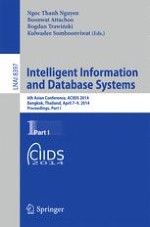The two-volume set LNAI 8397 and LNAI 8398 constitutes the refereed proceedings of the 6th Asian Conference on Intelligent Information and Database Systems, ACIIDS 2014, held in Bangkok, Thailand, in April 2014. The 125 revised papers presented were carefully reviewed and selected from 300 submissions. The papers address the following topics: natural language and text processing, intelligent information retrieval, semantic Web, social networks and recommendation systems, intelligent database systems, decision support systems, computer vision techniques, and machine learning and data mining. The papers are organized in topical sections on multiple model approach to machine learning, MMAML 2014, computational intelligence, CI 2014, engineering knowledge and semantic systems, IWEKSS 2014, innovations in intelligent computation and applications, IICA 2014, modeling and optimization techniques in information systems, database systems and industrial systems, MOT 2014, innovation via collective intelligences and globalization in business management, ICIGBM 2014, intelligent supply chains, ISC 2014, and human motion: acquisition, processing, analysis, synthesis and visualization for massive datasets, HMMD 2014.
